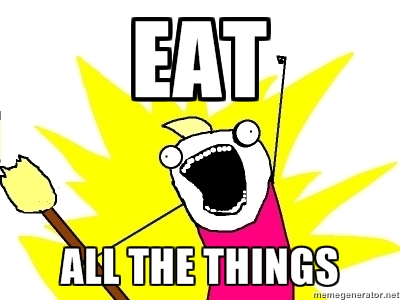I’ve been running high lately, and I don’t know why.

That’s a lie. I know why. I eat too much, too often, and too late. Or I don’t eat, and then I go low or get super hungry, and then I eat all the things. Dang those holiday treats!
I haven’t been working out, exercising, or bringing sexy back. I have a gym membership, so accessibility to a place to exercise certainly isn’t the problem. I always find some seemingly good excuse for not getting there. First I was busy trying to find a new place to live. Then I was busy moving. Then I hurt both hands during the move.

Then I got even busier than usual at work creating something that I am extremely excited about. We are starting a new diabetes journal, available to all, and we’re now accepting research and volunteers to be peer reviewers. Check out The PLAID Journal. You can see a couple of videos and news articles about the The PLAID Journal on the Announcements page. Also, the Facebook page for PLAID. (Lots more to come on PLAID, so stay tuned.)
Then the knee that I hurt while cycling several years ago flared up again. Add to all of that an ever-growing to-do list, and there is always something that keeps me focused on something other than me.
I hate it. I hate the feeling of my blood sugar being high. I hate that I can’t get my BG to stay where I want it. I hate when I prick my finger and see a number that is dramatically higher than I feel because my body is getting used to it. I hate being thirsty. I hate waking up in the middle of the night to go pee. I hate thinking about it. All. The. Time.
I also hate being overweight. I hate feeling like I am the overweight that I am. I know that we’re in an age where we are supposed to accept our bodies and all that jazz, but this is not normal. I can’t just accept this. I don’t feel like me at this size. I feel like I’m stuck in a heavy fat suit, and everything I do is just that much harder because of it.
But for whatever reasons, I can’t seem to change it.
Before April of this year, I was on Weight Watchers, and I was doing pretty well with it. I had lost over 10 pounds in three or four months, and was feeling pretty good. I was on track to get back to a weight and size that I wanted to be. And stronger. And back to a more human shaped geometry, instead of just round.

Today, I’m the heaviest that I’ve every been. Almost 207 whopping pounds. I put that out there for no other real purpose than to make it real. I should be about 170, in an ideal world. And I’ve seen a human skeleton. Short of an anatomical anomaly, there is no such thing as “big boned.” I’m just plain old overweight right now.
As joyous as April started out with Amanda and I tying the knot in beautiful Key West, it ended in tragedy with the loss of our precious little cat Squirt, and I know that losing her has played a role in where I am now. To some it may sound silly (she was so much more than “just a cat”), but she was a part of my life every single day for nearly 14 years. It feels like the loss of an immediate family member, because that is exactly what it is. I think dealing with that loss, on top of everything else already mentioned, has made me do things like eat my emotions and talk myself out of doing fun active things.
Working out and exercising has always been like therapy to me. Be it gym, walking, running, or cycling, it’s a safe place for me to get out all of my stress, frustration, anger, aggression, sadness, and any other negative emotions that I’m dealing with. Some days I only need 30 minutes or so. Other days I might need a couple of hours. It also makes sure that I have a few minutes during normal human hours of the day that are just for me, Martin Wood, where I’m not making sure that the needs of everyone else are being met.
It’s my career choice to help people, and it is a major part of who I am, and I love it, but sometimes in order to help people we have to make the time to help ourselves. I haven’t been doing enough of that. Now that we are in a neighborhood where there is less chance of going for a walk or run and interrupting a drug deal, I finally feel that spark of motivation to get out of the house and move around.
I also enjoy doing other things, like reading, video games, movies, and basically anything that doesn’t involve repairing yet another kitchen appliance in my house. Sometimes it’s hard to make room for those things, but we have to. Down time is as necessary to life as to-do lists and full calendars. A friend said recently that “cancelling a holiday commitment is like heroin.” Try it. Substitute an evening on the couch with the dog and the first half of this season of The Walking Dead. (Beth…noooooo!!!)
Life with diabetes is freaking hard, man. Life with diabetes is about so much more than just diabetes. Life with diabetes is a complicated balance of biometrics, medical therapies, activities, unexpected events, important considerations, random emotions, bright sides, dark places, and things left unsaid that have to be factored into an inarticulate equation that hopefully results in a personal definition of success.
All of this is what it takes to get my A1C where I want it, to get my BG’s on a more level plain instead of high or bouncing all over the place, to get back to Weight Watchers and better control of all of the delicious things that I’ve been cramming into my face hole, to develop the strength and stamina to avoid future injuries, and to drop some pounds and be able to haul ass without it taking two trips. That is what it takes to focus more on the things that I do have in my world that bring joy, for me, Martin Wood. Like these two…
That is what it takes to start to feel better. To feel happy. To feel able. To feel normal. And if I can’t do it on my own, then I’ll have to figure out who the right people are and get them on my bus to help me get further along down that road. For now, it’s one mile at a time.
–MW



























 (Click to read…)
(Click to read…)